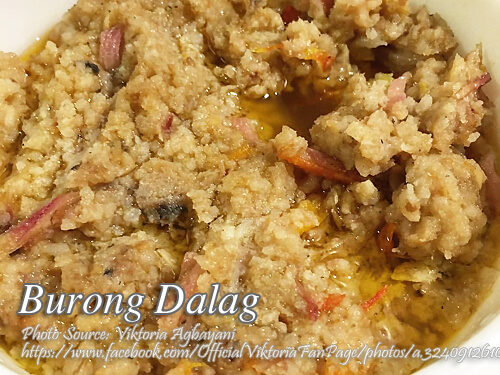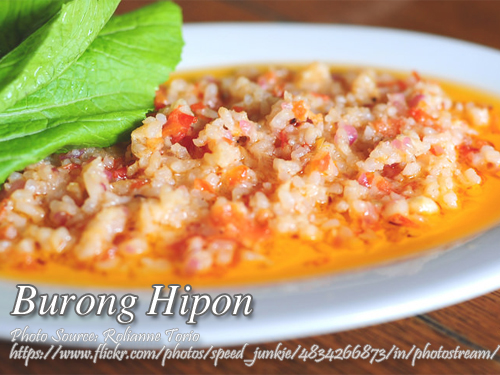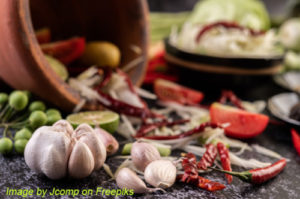This is a recipe of fermented mudfish with cooked rice, salt and fermented red yeast rice called “angkak”. A native Filipino delicacy from Pangasinan and Pampangga provinces. If you are wondering what is “angkak”, then it is what make the burong dalag looks more attractive by giving it a red pinkish color and will give the buro a distinctive taste.
“Angkak” is a bright reddish purple fermented rice, which acquires its colour from being cultivated with the mold Monascus purpureus. This is usually used in Chinese and Japanese cuisines which is available in Asian stores. Since this ingredient is not easily found and available in local wet markets, you can substitute it with food coloring since the main purpose of this red rice is for coloring dishes, just like achuete or annatto seeds. But nowadays you can purchase it online on your favorite shopping app.
Burong Dalag: A Nostalgic Filipino Delicacy
When I think of burong dalag, I’m transported to the warm, bustling kitchen of my Lola Ising in Pangasinan. The aroma of garlic sizzling in hot oil mingled with the tangy scent of fermented fish and rice would signal that something special was cooking. “This dish is not for everyone,” my Tito Jun would joke, “but if you grew up here, it’s the taste of home.” And he was right. This humble yet deeply flavorful delicacy holds a special place in many Filipino households, especially in the provinces of Pangasinan and Pampanga.
What is Burong Dalag?
Fermented mudfish is a unique Filipino dish made with mudfish (dalag), cooked rice, salt, and an optional splash of fermented red yeast rice called angkak. Angkak is what gives the buro its signature reddish-pink hue and adds a slightly earthy flavor that balances the saltiness.
If you’ve never heard of angkak, you’re not alone. This ingredient, often used in Chinese and Japanese cuisine, is made by fermenting rice with the mold Monascus purpureus. While it’s not always available in local markets, you can find it in Asian grocery stores. And if sourcing angkak becomes tricky, a dash of food coloring can work in a pinch, though it won’t provide the same nuanced flavor.
In many Filipino homes, this isn’t just a side dish; it’s a labor of love. It takes patience to ferment the fish properly, but the result is a dish that delivers an explosion of flavors: tangy, savory, and umami-packed.
The Art of Making Burong Dalag
My Ate Cora was the family expert when it came to fermenting fish. She taught me the process one summer while I was visiting her in Pampanga. The first step, she said, is to clean the fish thoroughly. Scraping off the scales and washing the pieces under running water ensures that the buro develops a clean, balanced flavor without any lingering fishy taste.
After cleaning, we rubbed the fish with salt and let it sit for a couple of hours. This step is crucial. The salt not only seasons the fish but also acts as a preservative, preventing unwanted bacteria from interfering with the fermentation process.
Next came the rice mixture. “The rice isn’t just filler,” Ate Cora explained. “It’s the backbone of the buro.” Cooked rice is combined with more salt and angkak, if available, then layered with the salted fish in an earthen jar. The traditional use of a palayok (clay pot) adds an earthy depth to the buro, but a wide-mouthed glass jar works just as well.
After sealing the jar tightly, we tucked it into a cool corner of the refrigerator. And then we waited.
Why Fermentation Works
The magic of fermented mudfish lies in the science of fermentation. When the rice and fish are combined, naturally occurring bacteria break down the proteins and starches, transforming the ingredients into a tangy, umami-rich mixture. The salt keeps harmful bacteria at bay, while the angkak enhances the flavor and color.
Traditionally, the fermentation process would take place in cool, dark storage spaces, but modern refrigeration offers a more controlled environment. After about a week, the buro is ready to be sautéed and enjoyed.
Sautéed Burong Dalag: A Flavor Explosion
The first time I tried making burong dalag on my own, I followed my Nanay’s advice to the letter. She always began by sautéing minced garlic in hot oil until golden brown. Then came the onions and tomatoes, their natural sweetness balancing the tanginess of the fermented mixture.
Once the base was ready, I added the buro, along with a splash of water to loosen the mixture. My Kuya Art swears by a pinch of MSG or vetsin to elevate the dish, and while some might skip it, I think it adds a little something extra.
The result was exactly how I remembered it from childhood: creamy, tangy, and bursting with umami. Served with a steaming plate of freshly cooked rice and a side of crisp vegetables, it was the perfect comfort food.
Variations and Substitutes
If mudfish isn’t available, tilapia or gourami are excellent alternatives for making buro. While each fish brings its own subtle flavor, the fermentation process ensures that the final dish remains true to its roots.
A Taste of History
Burong dalag is more than just a dish; it’s a reflection of Filipino ingenuity. In a time when refrigeration was scarce, fermentation was a practical way to preserve fish. Over the years, what began as a necessity evolved into a beloved delicacy, celebrated for its bold flavors and cultural significance.
The provinces of Pangasinan and Pampanga, known for their rich culinary traditions, continue to keep this dish alive. It’s a reminder of how food connects us to our past, our families, and our heritage.
Bringing the Tradition Home
Making burong dalag might seem intimidating at first, but it’s a rewarding experience that ties you to generations of Filipino cooks who perfected this process over time. Whether you’re recreating it for nostalgic reasons or simply curious to try a new dish, remember that every jar of buro is a story waiting to be told.
So, the next time you find yourself with a craving for something tangy and comforting, give fermented fish a try. You just might find that it tastes like home.
How to Make Burong Dalag (Fermented Mudfish)
Ingredients
- 1 pc large mudfish dalag
- 2/3 cup salt
- 3 cups cooked rice
- 1 Tbsp. angkak fermented red yeast rice
Instructions
How To Make Burong Dalag
- Scrape scales of fish. Slit at the back from head to tail and spread.
- Cut into 4 pieces. Clean by washing in running water.
- Drain and rub with salt. Set aside for 2 hours.
- Combine cooked rice, salt and angkak. pack fish and rice mixture in an earthen jar (palayok) or a bottle with wide mouth.
- Cover tightly. Store in the refrigerator. After one week, you may then saute the buro.
- Note: You can subtitute the mudfish with tilapia or gourami for your buro.
How to Saute the Burong Dalag:
- Saute minced garlic in oil until brown. Add chopped onions and tomatoes. Stir for 3 minutes, then add the burong dalag with the rice mixture.
- Add a little water and a dash of MSG or vetsin. Cook for 10 minutes.
Notes
Cooking Tips:
Clean the Fish Thoroughly for Better Flavor
When preparing mudfish, make sure to scrape off all the scales and wash the fish under running water to remove any impurities. This step ensures that the fermentation process produces a clean, tangy flavor without any unwanted fishy aftertaste. A well-cleaned fish is the foundation for a successful buro that’s both flavorful and appetizing.Use the Right Ratio of Salt to Rice
The balance of salt in the rice mixture is crucial for proper fermentation and flavor. Too little salt can lead to spoilage, while too much might overpower the dish’s delicate tangy profile. Aim for an even coating of salt in the rice and fish to achieve a harmonious blend of savory and umami flavors.Let the Fermentation Process Take Its Time
Patience is key when making fermented mudfish — allow at least one week for the fish and rice mixture to ferment. This time lets the natural bacteria develop the tangy and rich flavors that make this dish unique. Rushing the process may result in an underdeveloped buro that lacks depth and character.






The angkak is actually fermenting the fish, not just adding food coloring. Leaving it out noticeably changes the taste.
Hi Banana, thanks for the info.